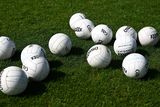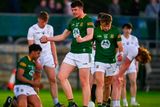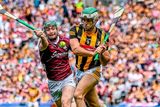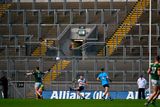No forgiveness as Christy's clubs make return to action
Perhaps Himself was casting a watchful eye from above as his tools were dusted off again
Noel Fox tests out the late Christy O’Connor Senior’s driver on the range. Photos: Damien Eagers
Two rather special clubs were tucked under my left arm as I approached the GUI's Academy at Carton House. First into view was national coach Neil Manchip, who, on eyeing the more forbidding of the implements, exclaimed: "I certainly wouldn't fancy that for my first shot of the day."
The object of last week's visit was to place remarkable Christmas gifts into expert hands. By arrangement, Manchip's PGA colleague, Noel Fox, had agreed to compare golf clubs from another era with their modern counterparts.
Making the exercise all the more attractive from Fox's perspective was that the last player to have hit the clubs was none other than Christy O'Connor Snr. And they were now my property, through the seasonal kindness of the great man's family.
We're talking about a Fred Smyth three-iron, stamped with the famous RC10 logo by way of commemorating Christy's 10th successive Ryder Cup appearance in 1973. Its partner was a classic persimmon driver from the MacGregor company, beautifully crafted with an unusually shallow face.
They were the sort of clubs Ben Hogan would have used when setting new standards for the professional game during the 1950s, the opening decade of O'Connor's tournament career. In this context, Hogan's famous US Open victory at Merion in 1950 was brought right back into focus by the 2013 triumph from Justin Rose in the same championship at that same historic venue.
Merion's 18th hole measured 458 yards when Hogan set up a 72nd-hole par with what became an iconic one-iron second shot of 200 yards, which came to rest 40 feet from the pin. When it was stretched to 511 yards four years ago, Rose slipped through the green with a four-iron from roughly the same position.
We're told that the lofts of irons have changed dramatically since Hogan's time, to the extent that by modern standards, the great man was probably playing a three rather than a one-iron for that fateful approach. The same loft difference in other irons through the range is attributed to clever marketing by equipment manufacturers.
On seeing Christy's clubs, Fox disappeared behind a partition in the Academy - from where the sound of warm-up striking was accompanied by a stream of balls penetrating the murky gloom of a winter's day. Then he reappeared ready for the test, saying: "It's such a great privilege to hit these clubs that I want to give it my best shot."
His first effort with the RC10 went 204 yards. Then, as the consequence of a much crisper strike, the second was measured at 215. The third one of 218 reflected a level of concentration you might associate with the most intense tournament play.
Fox seemed satisfied. "Miss the middle of the blade and you know all about it," he mused. "Much more challenging to hit than a modern club. But catch it right and the feedback is superb - right up the shaft, through the grip and onto the hands."
He figured he was dealing with a sweet spot about the size of a five cent piece, compared with a two euro piece for the modern implement. Then it was time for a modern blade which, courtesy of greater weight in the sole, he sent on a noticeably higher arc for a best hit of 221 yards.
"Far less challenging," he declared with a smile. "So in terms of distance, not much has changed in iron technology in the last 40 years. The key ingredient in extra distance is the ball, with help from oversize drivers." By way of ensuring that we were comparing like with like, he tested the clubs for loft. Christy's three-iron measured 20 degrees while the modern version, at 21, was virtually the same.
Fox then talked about a little groove left by O'Connor's left thumb in the grip of the three-iron. "It's more to the inside than I imagined it might be, indicating quite a strong left-hand grip, which would be in line with modern coaching," he said. "But I would have expected a more neutral grip from Christy."
When I asked him if the three-iron had even a hint of the forgiveness you would expect to find in abundance in the modern version, he replied: "No. There simply isn't any. That's a club only for a top amateur or a decent professional. In the hands of a handicap player, it would be an incredible experience for him to hit it out of the middle, maybe once a month."
All of which led Fox into fond reflection on a Links Society outing at Royal Dublin in the late 1990s. It was an occasion when his powerful drive over the old cross-bunkers on the long 11th prompted a celebrated playing partner to enthusiastically remove his headwear and fling it to the ground with the prediction: "I'll eat that hat if you don't make it at this game."
Sadly for Fox and his new-found mentor O'Connor, a sparkling amateur career was not followed by anticipated success on the professional circuit, though he is now quietly establishing himself as a gifted teacher with admirable insight.
Meanwhile, that treasured day on Dollymount's duneland ended in a manner befitting its resident genius.
"Of course I'd heard about Christy's bush on the 18th, and he wasn't far from it after a drive which, surprisingly, he drew off the ditch," he said. "Then he used the same black Ram Zebra driver to cut the ball off the deck, sending it over the Garden to about 20 feet from the hole.
"He must have been in his mid-70s at the time and I remember thinking that they were pretty amazing shots for a player of those years. Particularly the control he had over the golf ball.
"My brother James was caddying for me and we often talk about those shots -and how Christy rebuked us for sacrificing control by using soft golf balls. Amazing."
Which seemed a perfect cue for some shots with the MacGregor driver. Having searched for a tee that wasn't going to damage the precious face, Fox prepared to launch one of his finest.
Just before the crack of impact, however, he was aware of something drastically wrong. But it was only on seeing his sudden dash down the range that I realised what had happened. The wooden head, which hadn't seen action for several decades, had come adrift at impact and was eventually recovered by Fox about 50 yards away.
Walking back with the separated head, concern was evident in his face. On closer inspection, however, it transpired that no damage was done, though a fine crack was visible where the whipping had once held persimmon and steel firmly in place. Putting them together again, Fox bound them loosely as a temporary fix.
As a reminder of greatly changed times, he went on to remark that they no longer teach the art of whipping at the professionals' training school. "But I can still do it," he insisted proudly. "I learned from Peter Townsend when he was professional at Portmarnock."
That was when the notion struck me of intervention from the other side. Maybe Christy had decided that a faithful old servant had reached the end of its working life, and that it was now time to ease it into well-earned retirement in a suitable display case.
The thought instantly appealed to Fox as an explanation for the day's mishap, lending comfortable finality to an intriguing experiment.















